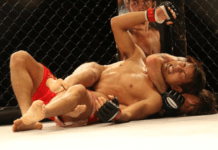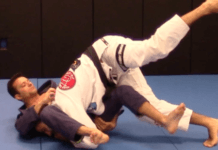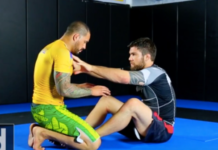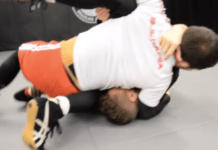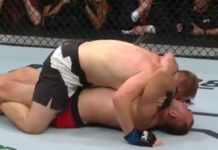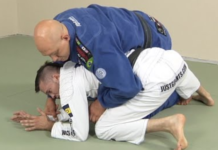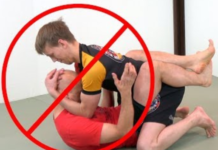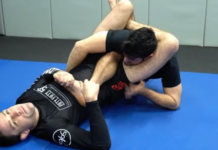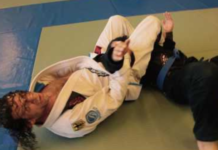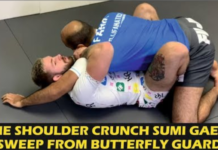BJJ is full of many amazing moves and techniques, by which your opponent can be defeated in many ways. You can use numerous levers and hyperextensions for this purpose. However, that’s not all jiu jitsu has to offer. Among the techniques of BJJ, there is also a huge group of different chokes. And one of the most popular submissions in this group is guillotine choke.
This choke is one of the highest percentage chokes in BJJ, MMA, and grappling. It is also very versatile, you can use it in both Gi and No Gi and also for self-defense. This technique has been used for hundreds of years and there are many different variations of this position. The guillotine choke is also seemingly simple to do, but at the same time extremely effective. All this just proves that it is worth spending a moment longer with this choke and finding out more about it. Check below for different variations of the guillotine choke and tips on how to bring it to perfection. There is also info on how to defend against guillotine choke!
Guillotine choke in a nutshell
The guillotine choke is one of the most basic moves in the entire BJJ arsenal. For those of you that are not well-versed in history, the guillotine was a device that was very popular during the French revolution from a few centuries ago – and it was used to behead the enemies of the revolution. By knowing this you will have an idea about what the BJJ guillotine is all about. However, under various names, this technique probably functioned much earlier than the guillotine was invented. Actually, it has been around for many centuries. Before BJJ the guillotine choke was for example practiced in Judo, where it is called mae hadaka jime that translates to front naked choke opposite the rear-naked choke.
How to perform the guillotine choke
To perform this choke you just wrap your arm around an opponent’s neck, lock your hands, and strangle. The technique is either a type of tracheal compression restraint (wind choke) that prevents airflow to the lungs or a blood choke depending on how it is applied. The most basic way to do a guillotine choke comes from the classical guard position in BJJ when you have a bottom guard. You can then do a crunch and put your arm around your opponent’s head in a way that your hand will rest directly under your opponent’s throat. Then use your other hand to clasp your first hand and then you begin to twist your opponent’s head. This will result in your opponent losing consciousness and going to sleep, or, much more seriously, in a serious injury to your opponent’s neck. The guillotine as a move is very effective and should never be taken lightly by the BJJ practitioners.
Variations of the move
Marcelotine
That being said, the guillotine is a flexible move and it has several variations. One of the most popular variations of this move was popularized by BJJ legend Marcelo Garcia – and it’s unhappily called the Marcelotine in his honor. The difference between the regular guillotine and the Marcelotine is that here you will put your forearms over your opponent’s trapezius muscles. This will put additional leverage on your opponent’s neck and it will increase the odds of the move being successful – if you can perform it right.
Arm-in guillotine choke
Then there’s the arm-in guillotine. You begin the move in the same way – you wrap your arm around your opponent’s head and under his throat, but you then clasp this arm of yours under the arm of your opponent. This submission is frequently seen in MMA matches – but this is not a 100% effective move and if you don’t do it exactly right then you may get your muscles burned out in the process for nothing. If you wish to see a demonstration of a failed application of this variant, then check the first fight of Woodley vs. Thompson in the UFC.
One-arm guillotine choke
Another version of the move is the one-arm guillotine. This is best done from the mount position but it can also be done from the half-guard. From the mount, you will wrap your hand around your opponent’s head and throat and then you will do two things: you will lift up your opponent’s head while pushing his body down with your hips. When done right this will create just enough pressure for your opponent to go to sleep or tap out. A notable example of this variation can be seen in the first fight of Michael Bisping and Luke Rockhold in the UFC.
Mastering guillotine
At first glance, a guillotine choke can look like a simple submission. It seems like you just wrap your opponent’s neck with your arms, pull up, squeeze and that’s all. However, there are a lot of nuances that you need to learn before this choke starts really working for you. People also tend to perceive the guillotine choke only as a submission, when the guillotine is far more. The first and most important thing to understand is that the guillotine is not only a choke but also a position. And to master the choke you need to practice the positional aspect first. You’ll need to learn to hold the guillotine, control your opponent, and stop him or her from escaping.
Guillotine as a position
Guillotine as a position is extremely efficient. It is because if guillotine choke does not work you will still have control over your opponent, you will be safe, and you can transition to other head and arm chokes. There are so many popular head and arm chokes that you can go to from the arm in the guillotine. For example, the arm triangle, the Darce, the Anaconda, and the arm in the north-south are all very good and have a high percentage. All of these techniques have been victoriously used in all of the forms of grappling.
Moreover, the guillotine can very easily be an incredible position for control, sweeping, countering, and passing the guard. Actually, using the guillotine to set up other positions is one of the best ways to utilize this technique. When you are able to wrap the head and get a good squeeze you have so much control over your opponent. One of the best sweeps from butterfly or half guard is threatening with a guillotine while at the same time using a butterfly hook to sweep your opponent and mount them. Such use of the guillotine is excellent because many people do not like to have their head wrapped like this. And when you have control, your opponent will focus on the choke and be much simpler to sweep. The same philosophy can be implemented from the top position. You can wrap the head from the top and many people will not be able to have as good of a guard. They will address the choke and you will be able to pass their guard much easier.
Guillotine choke
The guillotine choke is a true classic. We have seen high-level UFC fighters, BJJ fighters, and No Gi specialists use the guillotine with tremendous success. There are just so many variations of this choke. However, there is no single best guillotine. Each is good in its own way, and neither is better than the other. It is simply up to the person performing this technique which variation is best for them.
Best guillotine choke instructionals
To better understand the guillotine and thus improve your skills, it is also worth reaching for instructional videos. As always, great-quality movies from BJJ Fanatics will also work perfectly here.
Guillotine Revolution by Daniel De Groot
Daniel De Groot is a Dutch BJJ competitor and coach. His main accomplishments are winning the IBJJF No Gi European and no gi Brazilian championships, which makes him the only Dutchman to ever win the Brazilian championship. In the Gi, he has medalled at the IBJJF Europeans and won the IBJJF Curitiba Open. While in submission grappling he has won the elite categories of NAGA and Grappling Industries.
In 2015 he also started teaching classes. His students have competed and won some of the biggest tournaments in the Netherlands. What makes him a good trainer is that the things he teaches are proven effective. Actually, he is mostly competing to test the techniques he teaches. Daniel De Groot is certainly not a coach that tells you to do things he hasn’t applied in high-level competition. He shows only techniques that he is 100% sure will work, even against tough resistance.
It is no different with what he presents in this video. Daniel De Groot was able to make the guillotine one of his best techniques for winning high-level tournaments. The things that this tutorial shows are really battle proved. This material will give you a whole new perspective on this technique. Daniel De Groot shows what to look for and what changes to make to your use of the guillotine so that it becomes deadly effective. Thanks to this DVD your guillotine game will be revolutionized and your finish rate will go up.
Guillotine Choke Systems by Dante Leon
Dante Leon is a Canadian BJJ black belt and grappler. He is widely recognized as one of the most talented athletes of his generation. Leon gained his reputation while competing in the lower divisions of his BJJ belt. During this time, Dante won major IBJJF titles and beat such established competitors as Josh Hayden and ADCC medalist Rustam Chsiev. Thanks to his material you will learn some of the skills that guaranteed his success. In this DVD you will see how effectively sweep, pass, and submit the opponent from the guillotine. And the best thing about this video is the way Dante explains it all. He speaks about his guillotine choke system in a very understandable way, his teachings are easy to implement.
Defending the guillotine choke
There are a few ways in which you can escape from this move as well. If you can see that your opponent is gunning for your neck and for the guillotine move – then you can shrink your neck much like turtles do in the face of danger – and use your arms to block your opponent’s arms. If you’re caught from the bottom guard then the move will be ineffective if you can pass your opponent’s guard and into side-control.
A lot of BJJ novices make the mistake of continuing to hold to the guillotine for dear life when the choke is doomed to fail – in this way you even risk getting choked out with a Von Flue Choke. Finally, if your opponent has wrapped his hand around your head and clasped his hand with his other hand, then you can throw your arm behind your opponent’s back. This will alleviate the pressure to a great degree and it may enable you to get out of the predicament.

